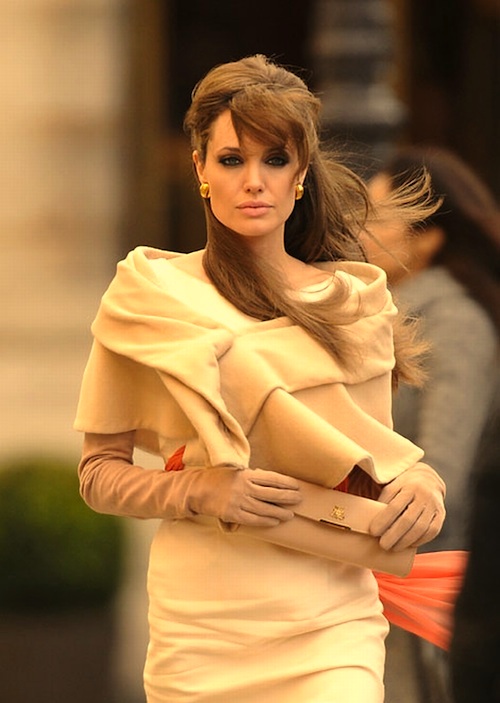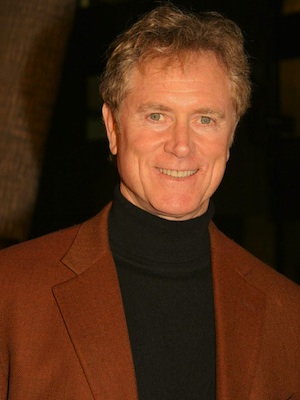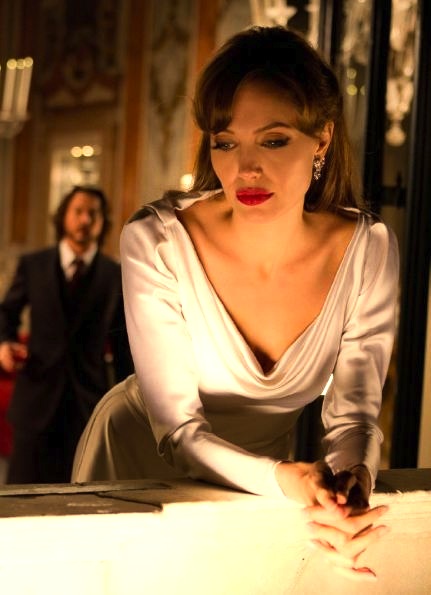
By Jason Apuzzo. Last week, after reading my unflattering one-line review of Atlas Shrugged, Part I, an individual I will refer to as ‘John Galt’ contacted me to express his pleasure with the review – and offer me a copy of Randall Wallace’s Atlas Shrugged screenplay from 2009, to which Angelina Jolie was attached. I accepted, being thoroughly convinced that the Atlas Shrugged currently in theaters in no way represented an adequate adaptation of Rand’s landmark novel.
For those of you who may not be familiar with Randall Wallace, he is the Oscar-winning screenwriter of Braveheart, who also wrote Michael Bay’s Pearl Harbor, wrote and directed We Were Soldiers, and most recently directed Disney’s superb drama Secretariat from last year (see my review of Secretariat here). Mr. Wallace is in every sense an industry pro, and someone whose experience at telling freedom-themed stories on a large scale made him a highly appropriate choice to adapt this material.
And for those few of you who may not be familiar with Angelina Jolie … you’re probably not even reading this article, because you’re living somewhere in the Alpha Centauri system. Let’s simply say that Ms. Jolie is commonly regarded as one of the few modern actresses capable of convincingly playing the role of Dagny Taggart, the feisty and charismatic heroine of Rand’s epic novel. Jolie herself has referred to Atlas Shrugged as a “once-in-a-lifetime” project, and appears to have been genuinely passionate about playing the part.
The producing team responsible for the Atlas Shrugged currently in theaters has hinted darkly that they’ve been objects of ‘liberal persecution’ in Hollywood, and that a ‘faithful’ rendition of Rand’s novel couldn’t possibly have been made in the Hollywood system though conventional channels.
I’m here to tell you that based on the Randall Wallace screenplay I’ve just read, nothing could be further from the truth.

Without getting into Atlas Shrugged’s complex history as a movie and TV project (about which distinguished Rand scholar Jeff Britting has written extensively), suffice it to say that in so far as Angelina Jolie was attached to Randall Wallace’s gripping, ambitious and faithful screenplay, there is no way that the producers of the current film can credibly claim that their downsizing of Atlas Shrugged was the necessary result of ‘liberal persecution.’ Sorry, but that dog doesn’t hunt.
When this kind of talent aligns around a project and it doesn’t come about, there are usually more prosaic reasons – typically having to do with scheduling, budgeting or poor management. Or, as was clearly the case here, the fact that writer-producer John Aglialoro (a first-time producer and screenwriter) was about to lose the rights to Atlas Shrugged – and therefore decided to rush the project into production with a shoddy script, and without proper funding or star power. That decision was tragic, based on the project that could have been made had Aglialoro surrendered the rights to people more capable of managing the film.
Reading Randall Wallace’s Atlas Shrugged screenplay (draft dated Feb. 10th, 2009) is, as a result, both an exhilarating and exasperating experience – given that it represents a vastly more thrilling, sexy, provocative, and genuinely epic telling of Rand’s story than the underwhelming effort currently in theaters.
For anyone who hasn’t yet seen Atlas Shrugged, Part I in theaters, or who hasn’t read Ayn Rand’s original novel, Atlas Shrugged centers around the indomitable and vivacious Dagny Taggart, who serves as the Vice-President in Charge of Operations for the Taggart Transcontinental railway. Surrounded by incompetents and worthless corporate bureaucrats, the detritus of a collapsing society – including, most poignantly, her feckless brother James – it’s the assertive Dagny who truly runs her family’s company, and in so doing keeps the nation’s railways operating. In Rand’s vast and quasi-apocalyptic story – set in an indefinite near-future, as America descends into abscesses of collectivism and fascistic rule – it is largely Dagny Taggart’s strength, persistence and resolute mind in the face of overwhelming odds that keeps the American economy from descending into chaos. At the same time, Dagny also becomes the focal point of a group of radical innovators and industrialists – led by the mysterious John Galt – whose intention is to overthrow the ‘collectivist’ forces in American society by means of a strike.

The first and most obvious difference between the Wallace and Aglialoro versions is that the Wallace screenplay compresses Rand’s nearly 1,200 page novel into a taut 130 pages, and does so by setting a fast pace. Wallace’s screenplay feels like it was written to the propulsive momentum of a freight train, as it whips readers from the valleys and gorges of Colorado, to the urban canyons of New York, to the White House (!), to a high-speed airplane pursuit, to spectacular train crashes and mine explosions, to a thrilling high-seas commando hijacking of a cargo freighter. After a brief introduction, the story opens with a rapid montage (reminiscent of Metropolis’ opening montage) capturing the speed and vitality of American industry. Wallace depicts the crackle of electricity across power lines, and communications data bouncing off satellites, as these marvels of modern invention push our economy.
Wallace’s Atlas Shrugged is always moving. Even the screenplay’s one major sex scene, between Dagny and Rearden, takes place all over Ellis Wyatt’s house – with bodies banging off walls and clothes flying in every direction. It’s a far cry from the chaste, family-friendly interlude of the Aglialoro version – and frankly, a great deal more entertaining.
Wallace also compresses the novel by taking a far more cinematic approach to the material than the drab Aglialoro version. For example, we first get to know Hank Rearden on the floor of his mill, among his loyal men, as he dramatically pours molten Rearden Metal out of a giant cauldron. Whereas in the Aglialoro version Rearden hardly gets his hands dirty, blandly watching his steel pour from behind the safety of a glass window (with bad CGI), here it’s almost as if we’re in the heart of a volcano – or in the forge of the gods. (I kept thinking of The Met’s version of Wagner’s Ring-cycle reading these scenes.) Before Rearden’s said a word, we already know what kind of man he is – a titan, a self-willed, self-determining man. Before he utters a peep about free market capitalism, we’ve already got his entire worldview in just a few moments, through his actions.

These colorful and pulpy elements are a large part of what made Rand’s original novel so popular and effective in communicating her ideas – and Wallace wisely leans on them, something the Aglialoro version neglected to do.
At the same time, Wallace invests a lot more energy than Aglialoro in exploring the character’s emotions. The Dagny Taggart, Hank Rearden and John Galt of Wallace’s screenplay are cerebral but also passionate figures, for whom ‘freedom’ and ‘self-reliance’ are more than mere intellectual concepts. They are, instead, emotional commitments that complicate relationships with the people they love, or to whom they’re tempted to feel indebted.
In Wallace’s screenplay there are two scenes that really stood out to me in this context. Dagny and Rearden have finally made wild love, after 60+ pages of excruciatingly sexy build-up. Rearden wakes up, looks out at the Colorado dawn, and begins to feel guilty. He is, after all, a married man – even though he’s married to a harpy wife (Lillian Rearden) who despises him. It isn’t just his infidelity that bothers him, however. It’s also that in the course of the evening’s epic carnality, Rearden feels that he reduced a woman he respected – Dagny, the ultimate business professional – into a mere lust object, and degraded her as a result.
Dagny listens to Rearden’s moping and self-recriminations, and then approaches him – stark naked (except for the bracelet of Rearden metal!). She tells him to look at her. He does. She then slaps him hard across the face, and tells him in no uncertain terms that he’s behaving like a fool. She reminds him that every sexual favor he took from her she gave him freely – and vice versa.
Then, realizing the business day is about to get started, she tells him she’s hungry – and jumps in the shower.
Now, that’s Dagny Taggart.
The moment is hilarious, poignant, decadently sexy, and really sells the Dagny character, even more than her moments of extreme business efficiency. One can only imagine, of course, what Ms. Jolie would do with such a scene. In any case, it’s precisely the sort of scene that the Aglialoro version of the story is lacking. The Aglialoro version of the film basically passes the Dagny-Rearden romance off as a standard-issue tryst, without recognizing the baroque psychology of the characters involved – two people who need each other, but who nonetheless are totally unwilling to surrender their autonomy.

Wallace gives us a very different side of Dagny later, however – the more tender and vulnerable side. This time she’s in Atlantis, and Galt is showing her around the place. They dip into a concert hall, where the composer Richard Halley is performing his music. The residents of Atlantis see Dagny coming in, and burst into applause – assuming she’s joined Galt’s cause. Facing the crowd, however, the tells them that she can’t join them. It’s just not what she does. She doesn’t quit. As she puts it to them simply, she’s Dagny Taggart and she runs a railroad. And no matter how much the world is falling to pieces, she will see things through. She then rushes off the stage, heartbroken, unable to look into their faces. It’s a great scene, effectively adapted by Wallace from Rand’s original version; it gives us a sense of Dagny’s deeply conflicted emotions.
Another major difference between the Wallace and Aglialoro versions is that Wallace’s screenplay feels much more at home in our contemporary world. In the Wallace version, Rand’s speeches are rendered into language and cadences that feel natural and everyday – while losing none of their philosophical potency. Indeed, Rand’s excursions into philosophy and economics are really much more impactful in the Wallace version as a result.
What’s more, Wallace’s screenplay does something bold that the Aglialoro version does not attempt: Wallace explicitly brings the White House in on the conspiracy to turn America into a socialist state, something that’s only implied in the version in theaters. The President and Vice President in Wallace’s Atlas Shrugged are fictionalized, yet written in such a manner that comparisons to the Obama White House would have been inevitable.

So the prospect looms that the Wallace-Jolie version of Atlas Shrugged would have been even more timely, more politically provocative and ‘relevant’ – while being sexier, more dramatic and action-packed, as well.
This is not to say that I loved everything about Wallace’s take on the material. I still feel that somehow Atlas Shrugged would best be dramatized either in an alternate version of 1957 (when the novel was published), or set in a different set of industries – the airline industry comes to mind – if set in the present. Also, from about 90 pages on, Wallace’s screenplay feels a bit rushed, as if he’s trying to pack a little too much in. The screenplay could easily have run a little longer in order to tie up more loose ends. I was also was disappointed that Wallace dropped the original novel’s Project X, the sonic death beam. No sonic death beam?! With Angelina Jolie around, it really seemed like a missed opportunity not to have her confront a sonic death beam!
Nonetheless, the Wallace version is so clearly superior in every way that it’s a great pity Mr. Aglialoro couldn’t have been more patient, and assembled all the proper pieces for his project – or else sold the rights to someone else. The Wallace screenplay stands as a marker for how fantastic a filmed version of Atlas Shrugged could’ve been. Wallace’s direction of Diane Lane in Secretariat was outstanding, and given his apparent interest in directing his Atlas screenplay, it’s thrilling to imagine what he and Jolie could’ve done – particularly after Jolie’s excellent work toplining last year’s anti-communist thriller, Salt (see our review here).
If there is a silver lining to the dark cloud of the Atlas Shrugged currently in theaters, it’s that only the first third of the novel has thus far been compromised. There is still time for Mr. Aglialoro to do the right thing and surrender the rights to Atlas Shrugged to people more capable of doing the novel justice.
The key question is whether Mr. Aglialoro and his team want to continue to turn Atlas Shrugged into a niche phenomenon of the libertarian/objectivist/Tea Party world, or actually bring Rand’s story to large, mainstream audiences. Based on Wallace’s script, this quite obviously would not involve compromising Rand’s message. Rand’s novel is one of the biggest selling books of all time, but it’s is currently being presented to the public like a $2 James O’Keefe video. It’s a little disappointing, when so much more could’ve been done with it.
Ayn Rand began her Hollywood screenwriting career in the 1920s working under Cecil B. DeMille. One can assume Rand learned many things working under DeMille, but one of those things was probably not to think small. The makers of Atlas Shrugged, Part I, however, have downsized Rand’s vision to a point of its being almost unrecognizable – as if the novel were called Homunculus Shrugged, rather than Atlas Shrugged. It’s time for them to recognize that when it comes to the scale of Rand’s vision, size does actually matter.
Posted on April 20th, 2011 at 10:16am.
I come here because this place fills a void in my searching for conservative entertainment news, namely sophistication. While I agree with all the differences you pointed out and I even agree with the idea that Part I was condensed, this script still basically feels like Part II and Part III to me. I can see the more impressive direction that you say this script would have taken the content, the audience it would have opened Rand up to, but so far as content is concerned, it’s not really much of a concern to me at all. Seems like they included all the big points and it seems like with so much left to discuss in Part II and Part III, they will certainly fill in the blanks of Dagny and Hank’s relationship as well as filling in the many facets to Dagny.
I guess that’s why I liked the film and wasn’t appalled by its limitations. I’m already in the club of those sympathetic to Rand and I am looking at it strictly as how it serves my purposes. You, undoubtedly, are looking at it from a broader perspective and see what the content could have achieved and how many more people it could have made sympathetic to Rand’s philosophy. I realize that view exists and I even recognize that accuracy, it’s just not the view I see myself.
Still, great review, nice to see what Atlas Shrugged could have been and nice to know it probably would have completely blown me away rather than just being enjoyable.
I appreciate your thoughts, Shin, as always.
What wasn’t clear in my “sophistication” comment is that I lack the ability to have that sophisticated look at film, that critical eye that tells me whether something is good or bad. I just go by what I enjoy. So I mean that you can see what I can’t, so I trust that this script you reviewed would have been better, even if I enjoyed the current version in theaters. Kind of lost that point in my aimless rambling. 🙂
We welcome your rambling here, Shin! No worries. 🙂
I was so excited when it was announced that Wallace was writing the script — if anyone could boill down the novel into one film, it was him.
Jason, I have to say that dropping Project X is worse than mishandling the Dagny/Reardon affair. You simply can not have Galt’s motor without having Project X — they’re inseparable foils that bring out the main theme of the film: Individuals create, and the government destroys. I think that’s way more important than examining the mind/body dichotomy through the affair.
I love your passion for story Jason, and I thought your “review” of Part 1 was very John Galt — you don’t owe anything to anyone, and you’re intellectual product is yours to do with as you wish … very cool.
That being said, you would be in my cool book forever if that script accidently falls into my email … just saying.
Vince, I’m afraid it would not be appropriate to send the screenplay along … as there are still possibilities hanging in the air – almost like static electricity, ready to be channeled into a great engine. 😉 As for Project X, yes, that was a disappointment! In almost every other way, however, Wallace’s version is far superior. Looking at the two projects, the comparison isn’t even close.
Thanks for your kind words, as always, Vince.
Sounds like a missed opportunity. Why did Randall Wallace write a script in the first place when it was owned by Aglialoro? I’m a bottom line person and unless I’m paid something appropriate for my time, effort and talent, why do it? Also what did you think of Pearl Harbor? We Were Soldiers is one of my favorite war movies. As you know, Pearl Harbor not so much.
My understanding is that late in the game Wallace wrote the screenplay for Aglialoro, but that money wasn’t found in sufficient amounts before the 2010 deadline to produce the Wallace version with Jolie attached. Which just begs the question: if you can’t get something done over 20 years, maybe somebody else should be doing it.
We Were Soldiers is very intense, very effective. In some respects I prefer it to Saving Private Ryan (different wars, of course). I’m apparently one of the few people left on Earth who liked Pearl Harbor, although I freely admit the film has its clunky moments – and the romance doesn’t really work for me. The Dec. 7th attack sequence, however, is really exceptional – and the overall breadth of the story is impressive. It’s the first film that made me notice Michael Bay, and I think he’s really upped his game since.
Count me in as huge Pearl Harbor fan. I also think We Were Soldiers is the best modern war film, along with Black Hawk Down and the last Rambo film — I’m serious about that.
Never got around to seeing the last Rambo pic …
Seriously, Jason — check out Rambo. It’s poetic, brutal, elegant, thematic, and brave — I can’t think of another war film that was shot miles from the actual war.
That’s really awful news about Hetherington. Restrepo was exhilarating — I’ve never seen that kind of tension in a documentary.
You’re killing me with this screenplay review. What about Ragnar? How was he presented?
I’ll make a point of checking out Rambo. You’ve got me intrigued …
Actually, I should’ve mentioned that Wallace’s Ragnar was really a highlight of the screenplay – he’s very prominent in the story, has a lot to do, kicks a lot of ass. He’s a sort of giant, Nordic bear with a wry sense of humor, always laughing. His character brings a sense of fun and adventure to the whole thing.
I agree with Vince on the last Rambo film. It showed what modern weaponry can really do to you on the battlefield. The attack sequence in Pearl Harbor is very good but the script is dreadful. Perhaps someone did rewrites on Randall’s original script.
The more I watch Saving Private Ryan the more I’ve grown to agree that is was not the Best Picture.(I was shocked and angry originally when it didn’t win) I do think it’s one of the best action war movies ever made but the second act is very very weak. For me, my favorite war movie is Bridge on the River Kwai.
Colonel Nicholson: [Recognizing Shears] You? – Alec Guinness
Major Shears: [Lunging at Nicholson] You! – William Holden
No matter how many times I watch that movie the last sequence literally gives me chills.
Yes, there’s nothing quite like that film. I would say there’s nobody like David Lean anymore, but there was never anyone like him ever.
It’s a sad day because of what happened in Libya today. Tim Hetherington, the maker of Restrepo was killed in combat today. In my opinion, Restrepo was the best picture of 2010. Truly Sad…..just another reminder that there’s a real war going on out there.
Yes, our reader Stephen noted that below in the Battlefield post. It’s quite tragic. These are the risks people are running to get these stories out.
http://www.businessinsider.com/tim-hetherington-oscar-libya-restrepo-2011-4
Well, the future ain’t over yet.
I haven’t seen Atlas, and I don’t plan on seeing it in the theatre. I’ve heard from too many people (whose opinion I trust) it’s not worth the $$. And if I went out of charity, wouldn’t that undermine the story?
However, I did start reading the book, finally. Wow, what an enjoyable read (so far). Rand’s prose it rough (it’s obvious English was a second language), however, she knew how to craft a story. Larger-than-life characters. Big stakes. Mystery. All that makes for a page-turner.
The 1000+ pages hasn’t daunted me yet, but see what I think in another 500 pages.
Absolutely finish the novel before even thinking of seeing the film! Your own imagination will do it better justice.
I too have noticed this ‘charity-case’ quality to what people have been saying about the film. It’s ironic in the extreme, given Rand’s message.
Fascinating review, Jason. Let’s not give up though. There are plenty of examples of movies being remade just a few years later and finding great success. Spiderman’s already getting a “reboot,” and the “Hulk” movies were literally just a few years apart. I’m sure there are other examples that you know of and I don’t. Maybe Aglialoro will give up the rights and let a true talent do it right. What do you think?
Alex
I totally agree, Alex. I still consider it possible that the novel will be adapted properly in the future – conceivably even in the near future.
No matter who directs the film, there will always be limitations due to expectations. You hinted at maybe the most glaring example. Richard Halley’s symphonies being performed on screen, but playing before a real audience in theaters. Anything less than a new Beethoven or Tchaikovsky masterpiece simply will be disappointing. The suspension of disbelief will be shattered if any attempt to bring Halley to the screen is attempted.
Now that I’ve seen AS part 1 I think the movie has 3 good things going for it.
1) It outed critics (Zero stars — really now!) who hold a vendetta against Rand for “The Fountainhead” where she held critics in contempt. Proving she was right I guess.
2) It outed elitists who lambasted it for using no-name stars even though at least two of them are quite enjoyable to watch.
3) It was worth seeing simply for the scene where Rearden visits the director of the State Science Institute. There he is told that politics and government funding forces science to do the pols bidding. Anyone you know to be wavering about the global warming scam should be taken with you to see the movie for that scene and its supporting incidents alone.
No, it is not a great movie, but it is worth seeing. If you have any more interest in my views, here’s the rest of my assessment: http://pascalfervor.blogspot.com/2011/05/atlas-mugged.html
Pascal, I appreciate your contribution here, but are aware that Rand herself was the ultimate ‘elitist’? Atlas Shrugged the novel is nothing so much as an epic of elitism, a monumental defense of cultural ‘elites’ and their value to society. And on a related note, Rand herself demanded to work with only the best in the Hollywood system. Read up on the history of The Fountainhead as a film project if you don’t believe me.
I’m sorry, but this populism vs. elitism theme really makes no sense in the case of this film. It’s really just an excuse for shoddy craftsmanship, as many non-liberal critics have attested.
Yes Jason, I am aware of her elitism that grew all the greater as she aged. At my site I’ve challenged the Randians on it on a couple of occasions, and none have had the gumption to take it up.
In the afterthought to my short review (at the link in my previous comment) I said much as you have here and much more. I hope you will forgive my quoting myself as I think it explicitly defends me of your charges of my naivety:
“She neglected to point out that after the man is gone, the corporation remains, and they who govern it [self-proclaimed elites] often have no regard for that which is in the human spirit that built the cat-bird seat that they now occupy.
This is precisely why benign despotism degrades into total despotism time and again. The son or heir to the throne has not an inkling or sense of what made his predecessor loved or at least tolerated. Nor does he have any sense of gratitude for all the good — derived from the liberty previously granted his subjects — that made life good for all. All he knows is that there are pretenders seeking to wrest control of the power from him, and he must protect the “precious” at all costs. “
Thanks, Pacal, I see where you’re coming from. I love this line: “This is precisely why benign despotism degrades into total despotism time and again.” Absolutely true.
Is there anywhere I might be able to find Wallace’s screenplay? I’m dying to read it. I’m a fan of Atlas Shrugged and refuse to see that atrocious looking movie.I wish more people understood that you can’t always do literal translations of some books on film. It’s a different storytelling vehicle and should be adapted. I’d rather a GOOD movie than a literal one. I read the book, I don’t need to watch it verbatim on screen.
Good points, Ross.
Alas, I need to keep the screenplay private. Frankly I’m hoping it can still be made!